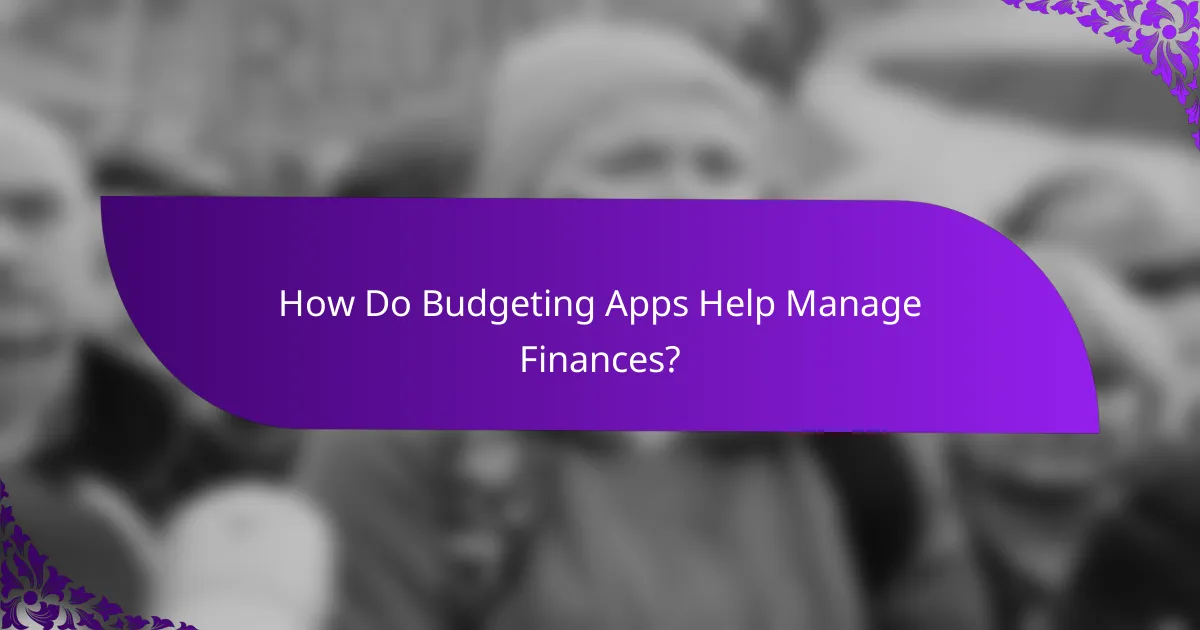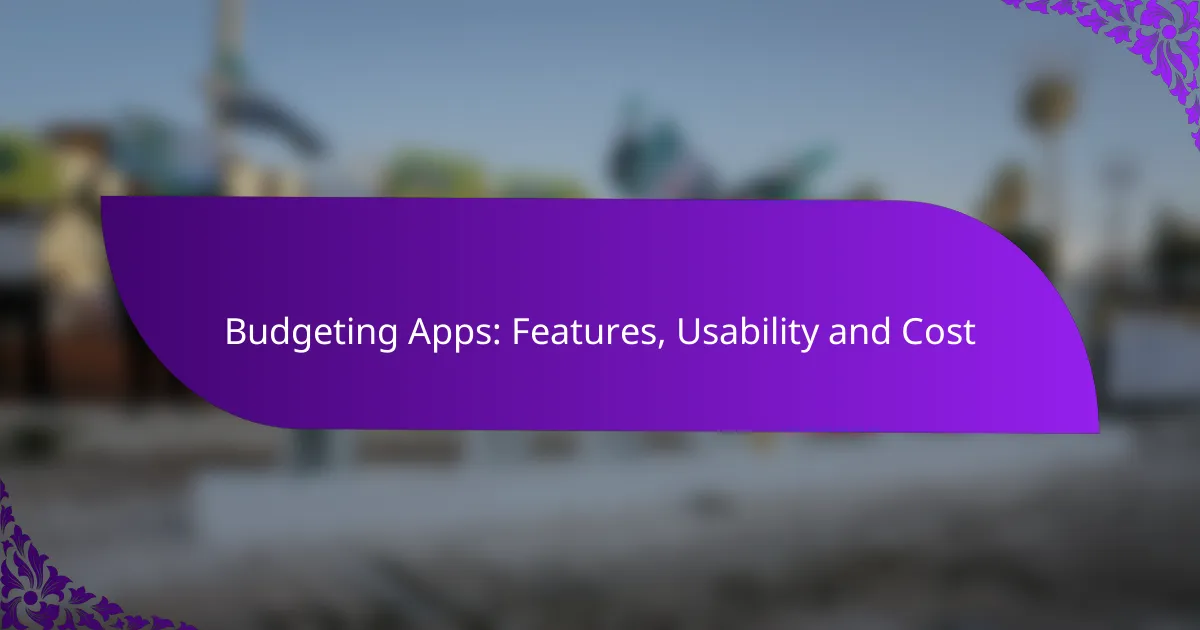In 2023, the best budgeting apps are designed to help users effectively manage their finances through a variety of features. With a focus on usability, cost, and tailored functionalities, these apps enable individuals to track spending, set financial goals, and generate insightful reports. By prioritizing key features like expense tracking and mobile accessibility, users can enhance their budgeting experience and gain better control over their financial health.

What Are the Best Budgeting Apps for 2023?
The best budgeting apps for 2023 offer a range of features to help users manage their finances effectively. Key considerations include usability, cost, and specific functionalities that cater to different budgeting styles.
Mint
Mint is a popular budgeting app that provides a comprehensive overview of your financial situation by linking to your bank accounts, credit cards, and bills. It automatically categorizes transactions, allowing you to track spending and create budgets effortlessly.
Users appreciate Mint’s user-friendly interface and the ability to set financial goals. However, some may find the ads and promotional offers distracting. It’s free to use, but you should be aware of potential upselling for premium features.
YNAB (You Need A Budget)
YNAB focuses on proactive budgeting, encouraging users to allocate every dollar they earn to specific expenses, savings, or debt repayment. This method helps users gain control over their finances and prioritize spending based on their goals.
While YNAB requires a subscription fee, many users find it worth the investment due to its educational resources and community support. A common pitfall is the initial learning curve, but the app offers tutorials to help users adapt quickly.
EveryDollar
EveryDollar is designed for zero-based budgeting, where users plan their monthly expenses down to the last dollar. The app features a simple drag-and-drop interface that makes it easy to adjust budgets as needed.
EveryDollar offers a free version with basic features, while the paid version includes bank syncing and advanced reporting. Users should consider their budgeting style; if you prefer a straightforward approach, EveryDollar is a solid choice.
Personal Capital
Personal Capital combines budgeting with investment tracking, making it ideal for users who want to manage both their day-to-day finances and long-term wealth. The app provides tools for tracking net worth and planning for retirement.
While Personal Capital is free to use, it does offer wealth management services for a fee. Users should be aware that the app is more focused on investment tracking than traditional budgeting, which may not suit everyone.
GoodBudget
GoodBudget uses the envelope budgeting method, allowing users to allocate funds to different categories or “envelopes” for spending. This approach helps users visualize their budget and avoid overspending.
The app is free with limited envelopes, while a paid version offers more envelopes and features. GoodBudget is particularly useful for those who enjoy a hands-on approach to budgeting, but it may not integrate with bank accounts, requiring manual entry of transactions.

How Do Budgeting Apps Help Manage Finances?
Budgeting apps assist individuals in managing their finances by providing tools to track spending, set financial goals, and generate detailed reports. These features enable users to gain insights into their financial habits and make informed decisions to improve their financial health.
Track spending
Budgeting apps allow users to monitor their spending by categorizing expenses and providing real-time updates. By linking bank accounts and credit cards, these apps automatically import transactions, making it easier to see where money is going. Users can set spending limits for different categories, helping to prevent overspending.
For effective tracking, consider regularly reviewing your spending categories. Many apps offer visual graphs and charts that highlight spending trends, making it simpler to identify areas for improvement. Aim to check your spending at least weekly to stay on top of your budget.
Set financial goals
Setting financial goals is a key feature of budgeting apps, allowing users to define short-term and long-term objectives. Whether saving for a vacation, paying off debt, or building an emergency fund, these apps help track progress toward each goal. Users can set specific amounts and deadlines, which enhances motivation.
To maximize effectiveness, break larger goals into smaller, manageable milestones. For instance, if saving for a home, set monthly savings targets that align with your overall timeline. Regularly update your goals based on changing financial circumstances to stay on track.
Generate reports
Budgeting apps can generate comprehensive reports that summarize spending habits, income, and savings over time. These reports often include visual aids like pie charts and bar graphs, making it easier to understand financial patterns. Users can typically customize reports to focus on specific time frames or categories.
Utilizing these reports can help identify trends and inform future budgeting decisions. For example, if a report shows high spending in dining out, users may choose to adjust their budget accordingly. Regularly reviewing reports, such as monthly or quarterly, can provide valuable insights into financial progress and areas needing attention.

What Features Should You Look for in a Budgeting App?
When selecting a budgeting app, prioritize features that enhance your financial management, such as expense tracking, bank synchronization, customizable budgets, and mobile accessibility. These elements can significantly improve your budgeting experience and help you stay on top of your finances.
Expense tracking
Expense tracking is a fundamental feature that allows users to monitor their spending habits. Look for apps that enable you to categorize expenses, set limits, and visualize spending trends over time. Many apps offer automatic categorization, which can save you time and provide insights into your financial behavior.
Consider apps that allow you to set alerts for overspending in specific categories. This can help you stay disciplined and avoid unnecessary expenses. A good budgeting app should also provide reports that summarize your spending patterns, making it easier to identify areas for improvement.
Bank synchronization
Bank synchronization allows your budgeting app to connect directly to your bank accounts, automatically importing transactions. This feature simplifies tracking and ensures your budget reflects real-time financial data. Look for apps that support multiple banks and accounts to give you a comprehensive view of your finances.
Ensure the app uses strong encryption and security measures to protect your sensitive information. Regularly review the synchronization settings to confirm that all transactions are accurately imported and categorized, which can help you maintain an accurate budget.
Customizable budgets
Customizable budgets enable users to create tailored financial plans that suit their unique needs. Look for apps that allow you to set budgets for different categories, such as groceries, entertainment, and savings. This flexibility helps you allocate funds according to your priorities and lifestyle.
Some apps offer features like rollover budgets, which let you carry over unspent amounts to the next month. This can be beneficial for managing irregular expenses. Evaluate how easily you can adjust your budgets as your financial situation changes, ensuring the app adapts to your evolving needs.
Mobile accessibility
Mobile accessibility is crucial for managing your budget on the go. Choose an app that offers a user-friendly mobile interface, allowing you to track expenses and update budgets anytime, anywhere. This feature is particularly useful for recording transactions immediately after they occur, reducing the chances of forgetting them.
Check if the app provides offline functionality, enabling you to access your budget without an internet connection. Additionally, consider whether the app syncs seamlessly between devices, ensuring your financial data is always up to date, regardless of the device you are using.

How Much Do Budgeting Apps Cost?
Budgeting apps can range from free to several hundred dollars, depending on their features and payment structures. Understanding the cost options available helps users choose the right app for their financial management needs.
Free options
Many budgeting apps offer free versions that provide basic features such as expense tracking and budget creation. These free options are ideal for individuals who want to manage their finances without any upfront costs.
However, free apps may come with limitations, such as fewer features, ads, or restricted access to customer support. Users should assess whether these limitations will impact their budgeting experience.
Subscription models
Subscription-based budgeting apps typically charge a monthly or annual fee, which can range from around $5 to $15 per month. These apps often provide advanced features like syncing with bank accounts, personalized financial advice, and detailed reporting.
When considering a subscription model, users should evaluate the value of the additional features against their budget. Some apps offer free trials, allowing users to test the service before committing to a subscription.
One-time purchase
Some budgeting apps are available for a one-time purchase, usually costing between $20 and $60. This model can be appealing for users who prefer not to deal with recurring fees.
While one-time purchase apps may offer robust features, users should ensure that they receive regular updates and support. It’s essential to check reviews and app longevity before making a purchase to ensure it meets ongoing budgeting needs.
